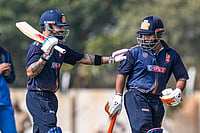PRIME minister Atal Behari Vajpayee says India is a nuclear weapon state and the world should recognise it as such. The scientific advisor to the defence ministry, A.P.J. Abdul Kalam, claims weaponisation is complete. He holds that India's nuclear tests validated "our capability in the design of nuclear weapons of different yields for different applications and different delivery systems (and) we have the capability to vacate nuclear threats".
Now consider the statements from the West. Just last week the joint Sino-US statement urged India and Pakistan to refrain from weaponisation and from testing or deployment of missiles capable of delivering nuclear weapons. This was no different from what the P-5 and the G-8 had earlier asked India and Pakistan to do.
So which is it? India says its a nuclear weapon state. The world tells it not to wea-ponise and specifically not to test or deploy missiles capable of delivering nuclear weapons. Says Lt Gen V.R. Raghavan of the Delhi Policy Group: "Based on the government's statements, an adversary will be justified in interpreting that India has ready, deliverable nuclear weapons of different yields and that it (the adversary) is entitled to take necessary measures to counter it."
Whether these are ready weapons or not, nobody knows, he notes, adding that earlier India had the capability and the equipment as well as having in place the assembly arrangements. "Obviously there has been movement beyond that. But since the government has said nothing (on ready weapons), the world will work on the interpretation that the nuclear weapons are instantly available," he says. "When you say we are weaponised, it means that you have completed the arrangements to marry the warheads to the delivery systems and fire them." He points out that if a country does not want the adversary to work on this interpretation, it "must be transparent. Nuclear deterrence is a dangerous situation if it is based on ambiguity".
Strategic analyst K. Subrahmanyam offers another view. He traces the confusion over India's nuclear policy and weaponisation to the government's failure to come out with a credible statement. "It's because of this that the US and the Chinese are saying don't weaponise. The answer to them is: thank you very much, didn't you know that we have weaponised for the last eight years? What do you do now? You can't roll it back."
What does the statement that weaponisation is complete and India is a nuclear weapon state imply? "That we are in a position to deliver a nuclear explosive on a designated target," says Subrahmanyam. India has had the capacity to drop bombs from aircraft since '90. "So it does not mean that without missiles you can't be a nuclear weapon state." But now India has the missiles (Prithvi) which have been tested and stored. "You don't store untested and unusable missiles," he asserts. Hence, he feels the controversy on weaponisation is completely needless.
Subrahmanyam explains that if you keep the warhead separately from its nuclear core, it is not technically a weapon. "This is the usual thing to do, to keep the two separately. Then you can swear with your hand on the heart that there is no weapon. It will just take half-an-hour or one hour to put it together. So this is really a play on words."
Brig Vijai K. Nair, executive director of the Forum for Strategic and Security Studies, who has authored a book called Nuclear India, does not think that there is any doubt on the part of any adversary that India has weaponised. Having said that, he and Subrahmanyam both emphasise the 'no first use' principle of the Indian nuclear policy—the Indian nuclear arsenal is to be used strictly if India is first hit by a nuclear bomb.
But for using this arsenal India needs to create a command and control system. As Nair says in his book: "Nuclear strategy becomes viable only if effective command and control is exercised over the diplomatic, military and intelligence constituents of the state in times of peace and crisis." The five nuclear powers have created elaborate C
3I (command, control, communications and intelligence) structures. These, Nair says, comprise personnel, a wide range of equipment and procedures that acquire, collate and analyse information to assist in the decision-making process, in reaching and transmitting decisions to different constituents of the force in real time and executing orders or modifying plans according to the demands of the political leadership.
Critics of the government say nothing is being done on this front. According to Raghavan, what is required is an array of radars all along the borders, satellite and surveillance systems, communications systems, control stations and linkages within them. "A nuclear weapon can't be used as an artillery shell. It is to be used only in political circumstances. Ultimately it will have to be the prime minister's decision to use it." He says even a moderate-sized C
3I would be a major exercise and an additional service would be needed.
The service chiefs have been asking for a command and control structure for some time, but it is only now that the government has started speaking about it. Vajpayee said recently that since the Indian nuclear doctrine was different from that of the nuclear powers, India did not need to replicate their command and control structures. This alarmed many inside and outside India.
But both Subrahmanyam and Nair feel that since the nuclear arsenal has existed for the last few years, some systems of managing them have also been worked out. Subrahmanyam says nuclear weapons can't be used in the battlefield. They are used only for three purposes—intimidation, against an adversary who does not have it and against an adversary in retaliation for an attack. India's purpose is to protect against intimidation and to ensure retaliation if the country is hit. The important thing is the command and control for that situation. The command, he says, will remain with the PM, who would need single-point military advice to decide if the country has been hit.
He argues it is necessary to provide for political and military succession. What if the capital is hit? In the US there is a list of 28 people, starting with the president and the vice-president, who can authorise a nuclear strike if the person ahead on the list has been killed. Similarly, says Subrahmanyam, now that there is no ambiguity on India's N-status, there should be transparency on issues like political and military succession and surveillance, without giving away the location of the arsenal.
Defence sources say an organisation called the Defence Intelligence Plans and Analysis Centre (DIPAC) at present assimilates information gathered by land, sea or airborne sources and passes it to field commanders, identifying the possible targets for them. Sources say the government must now work on developing a system in which orders can be sent down via the defence ministry to the services chiefs to the field commanders. For a viable C3I, sources say, the Indian satellites or airborne systems will also have to be equipped with sophisticated systems.
Clearly the government has to think through on these issues, for the nuclear weapons are here to stay.






















